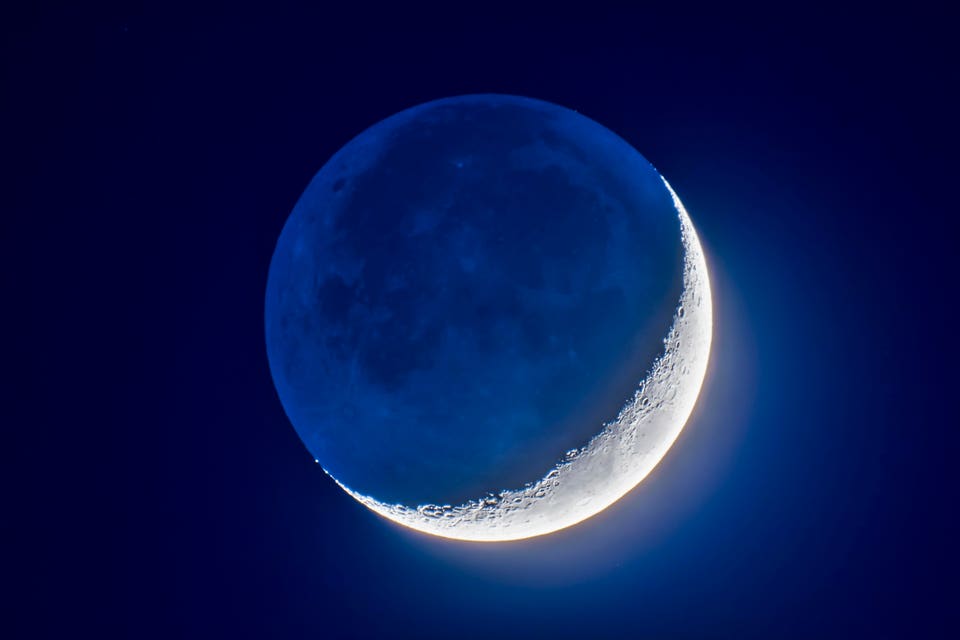See “Earthshine” on the moon this week. (Photo by: Alan Dyer/VWPics/Universal Images Group via Getty . .
. [+] Images) Each Monday, I pick out North America’s celestial highlights for the week ahead (which also apply to mid-northern latitudes in the northern hemisphere), but be sure to check my main feed for more in-depth articles on stargazing, astronomy, eclipses and more. The Night Sky This Week: January 8-14, 2024 If you’ve been trying to find an excuse to stargaze for the first time in 2024, make it this week.
With a crescent moon passing Venus as it shrinks to a new moon midweek the resulting dark skies will be ideal for picking out constellations. It’s a great week to find the likes of Taurus, Orion, Gemini and the Andromeda Galaxy, but also to watch the crescent moon re-emerge and visit Mercury and Saturn. Here’s everything you need to know about stargazing and astronomy this week: Monday, January 8: Crescent Moon And Antares Monday, January 8: Crescent Moon, Antares And Venus Look to the southeast an hour before sunrise this morning, and you’ll see an 11%-lit crescent moon shining less than a degree from Antares, a red supergiant star in the constellation Scorpius.
To the left of the pair will be a bright Venus. Tuesday, January 9: Old Moon Tuesday, January 9: Old Moon Look to the southeast an hour before sunrise this morning, and you’ll see a 5%-lit crescent moon shining below Venus. Thursday, January 11: New Wolf Moon Today, there’s a new moon, which is when our satellite is roughly between Earth and the sun—so lost in the latter’s glare.
A new moon is, therefore, invisible to us on Earth—the exception being a solar eclipse when the disk of the new moon can be seen moving across the sun’s disk. There’s one of those coming up on April 8 , which everyone in North America will see in some fashion (though only those in the path of totality will witness a total solar eclipse). Friday, January 12: Young Crescent Moon And Mercury Friday, January 12: Young Crescent Moon And Mercury You can be among the first to see the youngest, most slender waxing crescent moon this month, but it won’t be easy.
A 3%-lit slim crescent moon will be visible in the southwestern sky just after sunset, but will sink soon after. You’ll need a low western horizon and a pair of binoculars to scan the still-bright twilight sky to find it. A crescent moon also means completely dark, moonless skies during the night.
That makes this week an excellent time to go stargazing! Saturday, January 13: Crescent Moon And ‘Earthshine’ Saturday, January 13: Crescent Moon And ‘Earthshine’ An 8%-lit slim waxing crescent moon will be visible in the western sky just after sunset, slightly higher than last night and in the sky for somewhat longer. Look for “Earthshine” on the crescent moon’s dark side—sunlight reflected from Earth’s ice-caps and clouds onto the moon’s surface. Just above the moon will be Saturn.
Sunday, January 14: Crescent Moon, ‘Earthshine’ And Saturn Sunday, January 14: Crescent Moon, ‘Earthshine’ And Saturn A now 16%-lit crescent moon will again be visible in the western sky right after sunset. It will be bigger, brighter and more easily visible than last night. Put a pair of binoculars on its un-lit portion, and you’ll see “Earthshine.
” Tonight, it will be just above Saturn. Constellation of the week: Taurus Constellation of the week: Taurus Taurus “the bull” sits just to the upper-right of Orion, and you can spot it by looking towards the southeast in the early evening. It’s easy to identify because of its bright orange star Aldebaran, which marks the bull’s eye.
Within the boundaries of Taurus is a group of seven bright stars known as the Pleiades, which form a small open cluster. It’s surely one of the most beautiful objects in the night sky. Object Of The Week: The Andromeda Galaxy Object Of The Week: The Andromeda Galaxy Finding the Andromeda Galaxy can be a bit challenging, but it’s worth it.
While it’s possible to spot it with the naked eye in very dark skies, you’ll likely have a better chance if you use binoculars. To find it, first find the W-shaped constellation of Cassiopeia. Then look for the Great Square of Pegasus, which has four bright stars that form a large diamond or square.
Andromeda is roughly between these two constellations—you can find it by following the upper “V” of Cassiopeia, which forms an arrow that points straight to it. Andromeda looks like a big fuzzy blob in binoculars. It’s about 2.
5 million light-years away from the solar system. The times and dates given apply to mid-northern latitudes. For the most accurate location-specific information, consult online planetariums like Stellarium and The Sky Live .
Check planet-rise/planet-set , sunrise/sunset and moonrise/moonset times for where you are. I’m an expert on the night sky and author of Stargazing In 2024: 50 Easy Things To See In The Night Sky From North America . For the very latest on sky events and the total solar eclipse please subscribe or check my main feed regularly for new articles.
Wishing you clear skies and wide eyes. .
From: forbes
URL: https://www.forbes.com/sites/jamiecartereurope/2024/01/07/see-a-new-wolf-moon-visits-venus-and-saturn-in-dark-skies-the-night-sky-this-week/



